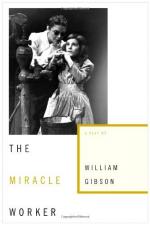|
This section contains 1,003 words (approx. 4 pages at 300 words per page) |

|
Near the conclusion of Two for the Seesaw, the rambunctious street urchin, Gittel Mosca, is gently informed that "after the verb to love, to help is the sweetest in the tongue." William Gibson, setting aside more serious concerns to anatomize the sweeter, softer virtues, has thus far dedicated his dramatic career to the definition and conjugation of these two verbs.
For, like the play which preceded it, The Miracle Worker—written with the same wit …—is essentially a two-character work about the relationship of kindness to love. The time has been set back to the 1880's, the seesaw has been freighted from New York to Alabama, and precariously balanced upon it now are an afflicted child and a 20-year-old Irish girl from Boston; yet, the two plays are clearly lifted from the same trunk. In outline, both works are about the redemption and education of a helpless little...
|
This section contains 1,003 words (approx. 4 pages at 300 words per page) |

|


